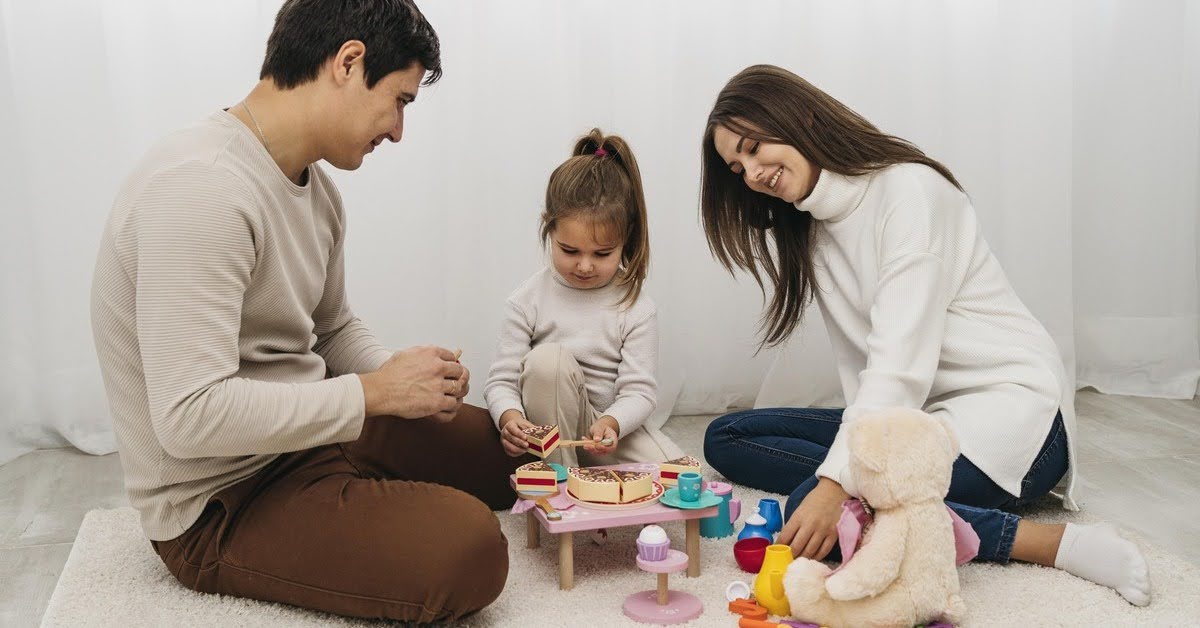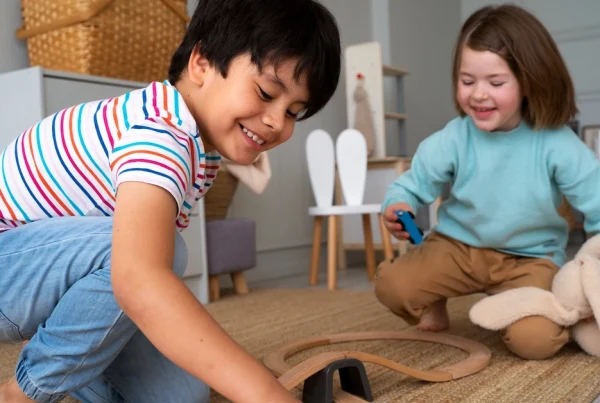Albert Einstein once said, “Logic will get you from A to Z; imagination will get you everywhere.” This simple quote highlights the timeless importance of fostering creativity in a child’s learning journey. Especially now in our busy world filled with routines and screens, nurturing your child’s imagination isn’t just important – it’s utterly crucial. This article will help you understand why letting creativity blossom in your kids is a big deal.
Plus, we’ve got seven easy tips for you to ensure that your child’s imagination is always buzzing with excitement. Let’s jump into the world of nurturing imagination and see how it can make endless possibilities come alive for your children!
The Role of Imaginative Play in a Nurturing Your Child’s Imagination
Imaginative play, also known as pretend play or dramatic play, refers to a type of play where children use their imagination to create scenarios, characters, and narratives. During imaginative play, children engage in activities that involve pretending, role-playing, and make-believe. This form of play allows children to explore and make sense of the world around them in a creative and unstructured way.
According to HealthyChildren.org, incorporating imaginative play can help boost confidence as well as language development and social-emotional learning.
Imaginative play is not only enjoyable for children but also crucial for their cognitive, social, and emotional development. It helps them develop problem-solving skills, creativity, empathy, and the ability to understand and navigate various social situations. Through imaginative play, children learn to express themselves, cooperate with others, and explore their own interests and curiosities in a fun and imaginative way.
Here are some tips on encouraging and enhancing imaginative play in your child’s daily activities:
1. Storytelling Adventures
Foster a love for storytelling by embarking on whimsical adventures with your child. Transform a corner of your home into a cozy storytelling haven where your child’s imagination can take flight. Dive into enchanting tales of magical realms, valiant heroes, and mythical creatures.
You can also explore the rich tapestry of biblical adventures, from Moses leading the Israelites through the parted Red Sea to the courage of David facing Goliath. To cultivate their creativity, leverage story starters to ignite their imagination.
Prompt them with phrases like “imagine if” to encourage active participation in crafting the narrative. Engage your child in the storytelling process by inviting them to contribute to the plot, invent characters, or illustrate scenes from the story. This not only sparks their creative flair but also fortifies their language skills.
2. Artistic Exploration
Unleash your child’s creativity through artistic expression. Set up a dedicated art space with various materials like crayons, paints, and craft supplies. Allow your child to experiment with different mediums and let their imagination guide their artistic endeavors.
Encourage them to create their own masterpieces, whether it’s a colorful drawing, a sculpture made from recyclable materials, or a handmade storybook. This hands-on approach not only nurtures their creativity but also boosts their confidence in expressing themselves.
Moreover, recognize the significance of showcasing their imaginative creations as an integral part of positive reinforcement and acknowledgment. Proudly display their artwork in a designated gallery or frame, creating a visual celebration of their creative achievements.
This not only instills a sense of accomplishment but also serves as a powerful motivator for further creative expression. By giving their creations a place of honor, you affirm the value of their artistic efforts, nurturing a continued passion for exploration and self-expression.
3. Nature as a Classroom
Take advantage of the great outdoors to nurture your child’s imagination. Nature provides a perfect setting for exploration and imaginative play. Whether it’s a trip to the park, a hike in the woods, or simply playing in the backyard, the natural environment stimulates a child’s senses and sparks their creativity.
Encourage activities like scavenger hunts, where they can discover the wonders of nature or play pretend using natural elements as props, reminiscent of how Noah might have cared for the animals on the ark.
Share the tale of Noah and the ark as part of their outdoor adventure, weaving it into the fabric of their creativity and imagination. Ask them to imagine the sounds of animals on the ark or the sensation of raindrops falling, connecting the biblical story with the tangible experiences they encounter in nature.
Read more: Benefits of Water Play for Children’s Development
4. Role-Playing Time
Encourage your child to engage in role-playing activities. Provide them with costumes, props, and a variety of characters to choose from. Whether they want to be a scientist exploring uncharted territories or a chef creating culinary delights, role-playing allows children to step into different roles, fostering creativity and empathy. Join in on the fun by participating in the role play, and watch as your child’s imagination transforms ordinary moments into exciting adventures.
5. Create a DIY Imagination Kit
Assemble a DIY imagination kit filled with assorted items like colored paper, glue, scissors, cardboard, and other crafting materials. When boredom strikes, let your child dive into their imagination kit to create anything their heart desires.
Whether it’s building a cardboard spaceship, crafting a paper crown, or inventing a new creature, having a designated space for imaginative projects empowers children to explore their creative instincts independently.
6. Plan Imaginative Playdates
Whether it’s a magical tea party, space exploration adventure, or dinosaur discovery zone, incorporating imaginative playdates into your child’s social calendar can cultivate a world of wonder and creativity. Encourage dress-up, provide a few thematic props, and let their imaginations run wild.
These playdates not only offer a break from routine but also allows for social skills, teamwork, and problem-solving—all while creating cherished childhood memories. So, don’t just schedule playdates; curate experiences that spark your child’s imagination and make their playtime truly extraordinary.
7. Imaginative Puzzles and Games
Introduce puzzles and games that stimulate their imagination and creativity. Opt for puzzles with vibrant and whimsical designs, encouraging your child to piece together fantastical scenes. Board games that involve storytelling or creative problem-solving also provide an excellent platform for creative thinking. These activities not only entertain but also challenge your child’s mind, promoting cognitive development and strategic thinking.
8. Ask Thought-Provoking and Broad Questions
Encouraging your child to ask interesting questions and think creatively is a great way to help them express themselves and show that their ideas matter. You can ask questions like “What do you think will happen if…?” or “How are dogs and cats different?” or “Can you think of other ways to solve this?” These questions can make your child’s imagination grow and help them get better at thinking critically.
Read more: The Role of Parents in Early Childhood Education
Conclusion
In the tapestry of childhood, imaginative play, with its storytelling adventures, artistic explorations, and nature-inspired escapades, becomes more than a source of joy—it becomes a conduit for spiritual, cognitive, and emotional development. In short, supporting and nurturing your child’s imagination is a powerful way to help them reach their full potential. It also helps them feel more confident and ready to deal with the challenges they’ll face in life. In the vibrant halls of SPH, we recognize that play and imagination is not merely a break from academic pursuits but a powerful tool for learning.
In the kindergarten years, our play-based learning approach creates an environment where exploration and discovery are intertwined with educational objectives. Through carefully curated activities, young learners engage with various materials, interact with peers, and develop fundamental skills while fostering a love for learning.
As students transition into the early primary years, the play-based learning approach continues to evolve. Structured play activities are designed to reinforce core academic concepts, creating a bridge between fun and foundational knowledge.
Our educators, acting as facilitators, guide students through play-based learning experiences that not only build a robust academic foundation but also nurture essential life skills such as collaboration, communication, and critical thinking.
As parents, guardians, and educators, let us collectively embrace the responsibility and privilege of nurturing the seeds of imagination. Through the magic woven into these activities, our children are not merely reaching destinations; they are soaring toward a future filled with faith, creativity, and a boundless sense of divine possibilities.
Curious to see how we foster creativity in young minds at our preschool? Visit preschool Jakarta to learn more about our engaging curriculum today!









